Commonly known as the Beige Book, this report is published eight times per year. Each Federal Reserve Bank gathers anecdotal information on current economic conditions in its District through reports from Bank and Branch directors and interviews with key business contacts, economists, market experts and other sources. The Beige Book summarizes this information by District and sector. An overall summary of the twelve district reports is prepared by a designated Federal Reserve Bank on a rotating basis.
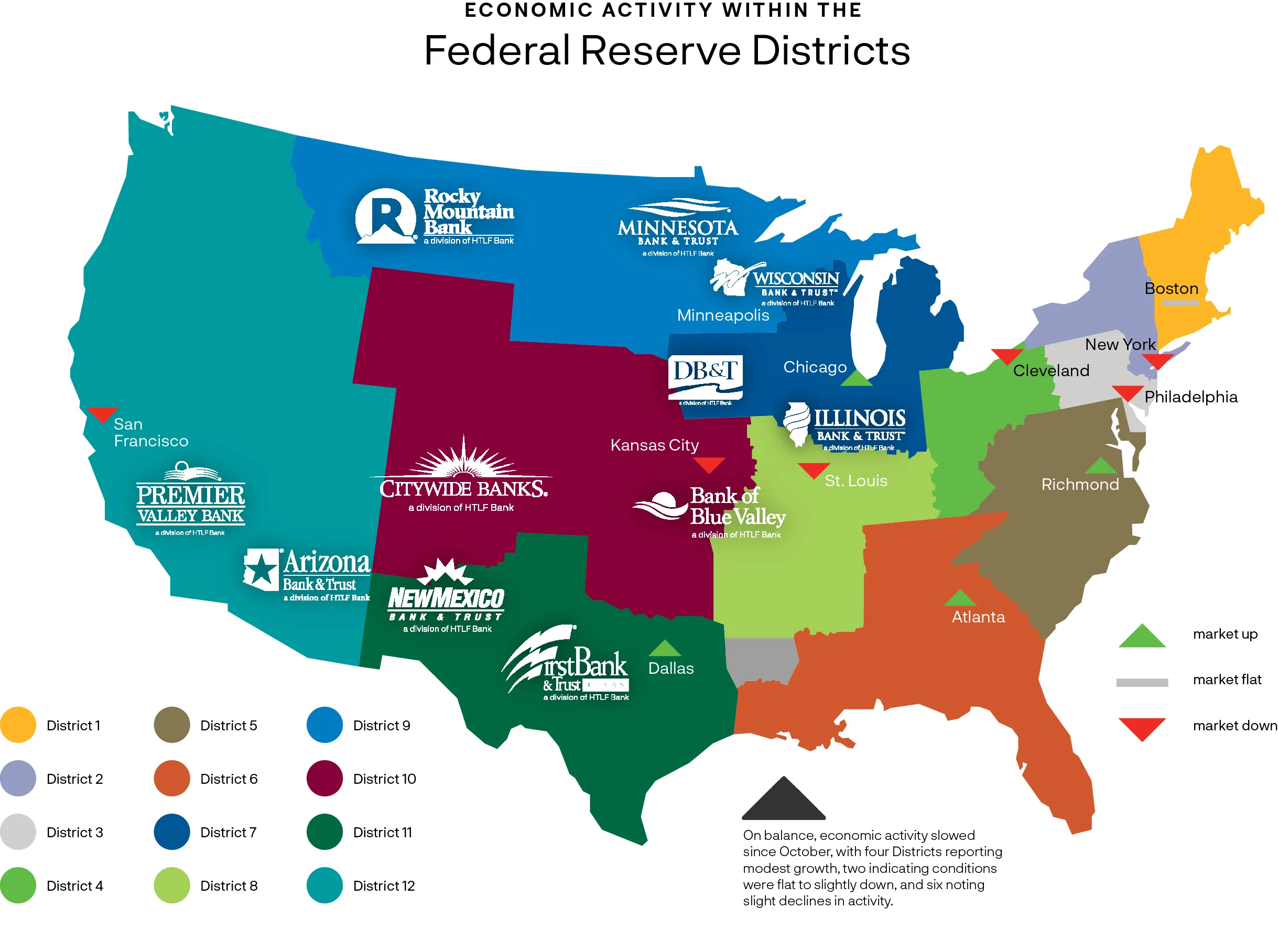
Overall Economic Activity
Retail sales, including autos, remained mixed; sales of discretionary items and durable goods, like furniture and appliances, declined, on average, as consumers showed more price sensitivity. Travel and tourism activity was generally healthy. Demand for transportation services was sluggish. Manufacturing activity was mixed, and manufacturers’ outlooks weakened. Demand for business loans decreased slightly, particularly real estate loans. Consumer credit remained fairly healthy, but some banks noted a slight uptick in consumer delinquencies. Agriculture conditions were steady to slightly up as farmers reported higher selling prices; yields were mixed. Commercial real estate activity continued to slow; the office segment remained weak and multifamily activity softened. Several Districts noted a slight decrease in residential sales and higher inventories of available homes. The economic outlook for the next six to twelve months diminished over the reporting period.
Labor Markets
Demand for labor continued to ease, as most Districts reported flat to modest increases in overall employment. The majority of Districts reported that more applicants were available, and several noted that retention improved as well. Reductions in headcounts through layoffs or attrition were reported, and some employers felt comfortable letting go low performers. However, several Districts continued to describe labor markets as tight with skilled workers in short supply. Wage growth remained modest to moderate in most Districts, as many described easing in wage pressures and several reported declines in starting wages. Some wage pressures did persist, however, and there were some reports of continued difficulty attracting and retaining high performers and workers with specialized skills.
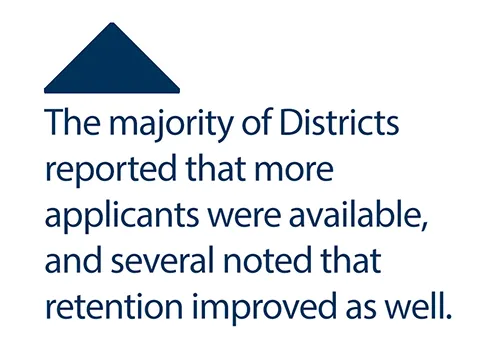
Prices
Price increases largely moderated across Districts, though prices remained elevated. Freight and shipping costs decreased for many, while the cost of various food products increased. Several noted that costs for construction inputs like steel and lumber had stabilized or even declined. Rising utilities and insurance costs were notable across Districts. Pricing power varied, with services providers finding it easier to pass through increases than manufacturers. Two Districts cited increased cost of debt as an impediment to business growth. Most Districts expect moderate price increases to continue into next year.
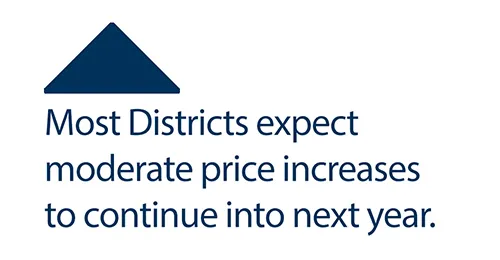
Outlook Across the 7th District
Economic activity in the Seventh District was up slightly overall in October and early November. Contacts generally expected a small decline in demand over the next year and many continued to express concerns about the potential for a recession. Employment increased moderately; business spending was up slightly; nonbusiness contacts saw little change in activity; consumer spending and construction and real estate activity decreased slightly; and manufacturing was down modestly. Prices and wages rose moderately, while financial conditions tightened slightly. Expectations for farm incomes in 2023 were little changed.

Labor Markets
Employment rose moderately over the reporting period and contacts expected a similar rate of increase over the next 12 months. Some manufacturers continued to have difficulty finding workers, particularly higher skilled ones. However, there were also signs that the labor market was cooling. Some contacts said their applicant pools had grown and that turnover had declined. And some contacts in construction, real estate, and finance reported taking down job postings, while others in those sectors were planning for layoffs. Wage and benefit costs rose moderately, but several contacts said wage pressures had cooled.
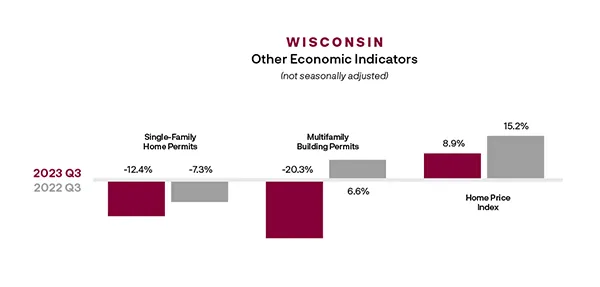
Source: FDIC State Profile
Prices
Prices rose moderately in October and early November and contacts expected a similar rate of increase over the next 12 months. Nonlabor costs were up moderately, in part because of increases in energy and shipping costs. Some contacts noted that while they had fewer supply chain issues, raw materials remained expensive. A few producers said that they were getting more pushback on price increases. Consumer prices moved up moderately due to solid demand and the passthrough of higher costs.
Consumer Spending
Consumer spending decreased slightly on balance over the reporting period. Nonauto retail spending was up slightly. Contacts highlighted higher spending on luxury items, new product lines, lower-priced items at outlet stores, and at e-commerce websites. However, a processor of product returns reported that returns of clothing and electronics were down, which is an indicator of lower sales of those items. In the leisure and hospitality sector, spending fell on air travel and hotels. Light vehicle sales decreased modestly overall. New vehicle sales were down but held up better than expected in light of the UAW strike, with several dealers commenting they saw little effect from the strike. Used vehicle sales fell. Contacts noted that lower-end used vehicles were selling faster than higher-end models.
Business Spending
Business spending increased slightly in October and early November. Capital expenditures moved up slightly, with several contacts reporting purchases of new software. That said, a number of contacts said higher interest rates and tighter lending standards were leading them to hold off on investments until credit conditions loosen. Demand for heavy truck transportation services declined moderately. Residential and commercial electricity usage decreased modestly, but industrial electricity consumption was up some, with one contact noting an increase after the end of the UAW strike. Inventories for most retailers were near desired levels. According to contacts, the UAW strike had little effect on overall auto inventories. In manufacturing, inventories were generally a little high. Most contacts noted fewer input shortages overall, though some remained, including for specialty electrical and polymer components.
Manufacturing
Wisconsin manufacturing activity expanded modestly in October. In durables, production increases were led by fabricated metals and machinery manufacturing. However, output in transportation equipment manufacturing declined, and a contact noted that the UAW strike somewhat hurt sales. Output rose in nondurable manufacturing. Chemical production was mixed, and refinery activity decreased. Overall, manufacturing outlooks worsened, and uncertainty remained elevated with several contacts citing geopolitical instability and high interest rates as headwinds.
Agriculture
Projected farm income in the District was little changed over the reporting period as both expenses and expected revenues moved lower. Despite widespread drought, there were reports of record yields across multiple states and crop types, including corn, soybeans, tomatoes, and wheat. One contact mentioned that early and dry spring planting contributed to better-than-expected crop yields. Corn and soybean prices dropped to their lowest levels in over two years, while wheat prices were flat. Costs were lower for key crop inputs, including fuel and fertilizer. Egg prices edged up, milk prices were flat, and butter prices were down. Cattle and hog prices both declined.
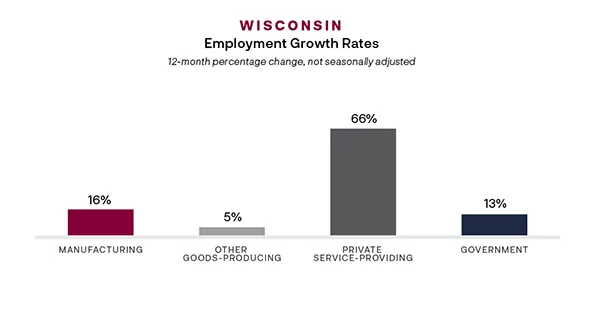
Construction And Real Estate
Construction and real estate activity decreased slightly on net over the reporting period. Residential construction was down slightly with demand for major remodeling projects falling substantially. According to a survey, homebuilders were more pessimistic about activity in the coming months than they had been earlier in the year. Residential real estate sales decreased slightly, while continued low home inventories supported a slight increase in prices and rents. Nonresidential construction activity was unchanged as were prices of new construction. Contacts again reported that high interest rates were forcing previously financially viable projects to be delayed indefinitely. Commercial real estate activity declined slightly, though vacancy rates and the availability of sublease space also fell. Prices and rents edged down. One contact reported that while leasing activity had held up, sales activity had fallen off.
Get Your Financial Feed Today
The Financial Feed is the premiere publication for banking insights. Each issue prioritizes strategies on how business leaders can continue to grow despite possible economic headwinds. We hope these findings help you conquer potential challenges and capitalize on opportunities.
Source: The Federal Reserve’s Beige Book
These links are being provided as a convenience and for informational purposes only; they do not constitute an endorsement or an approval by HTLF of any of the products, services or opinions of the corporation or organization or individual. HTLF bears no responsibility for the accuracy, legality or content of the external site or for that of the subsequent links. Contact the external site for answers to questions regarding its content and privacy rules.

